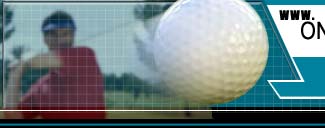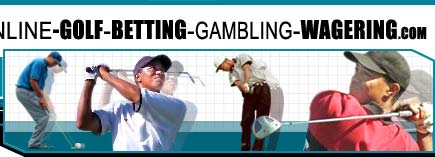|
|
|
The golf
grip
is perhaps the most fundamental aspect of the golf swing. It is
your only means of contact with the club and ultimately the ball.
Consequently a proper grip is essential to a controlled and constant
swing. The objective is to adopt a relaxed but firm grip which exercises
club head control i.e. prevents any twisting of the shaft causing the
clubface to open or close at the moment of impact with the ball. The
following stages illustrate the classic golf grip for a right handed
golfer. Note, most clubs have markings on the grip which assist the
positioning of the hands.
Step 1
Lay the club diagonally across the palm of the left hand, starting
with the middle knuckle of the forefinger and ending with the base
of the little finger.
Note the overhang of approximately 2 cm. |
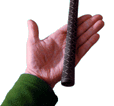 |
Step 2
Close the left hand around the grip with the thumb slightly right of
the shaft centre.
The clubface should be parallel to the back of the
hand. |
 |
Step 3
Bring the right hand to the shaft such that the grip rests on the
middle joints of the second and third fingers.
The little finger can
either interlock or overlap the forefinger of the left hand. |
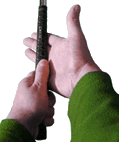 |
Step 4
Close the right hand around the the grip with the thumb resting left
of the shaft's centre.
The palm of the right hand should now be
parallel to the backside of the left hand.
|
 |
|
|
The stance is the foundation of the golf
swing and is therefore highly important. This section describes the
classic stance otherwise known as the 'box stance'.
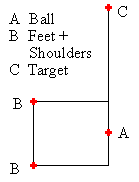
As the diagram shows you should stand parallel to an imaginary line
drawn from the ball to the target. The legs should be spread such that
the feet and shoulders are on the same vertical plane. The ball should
be an equal distance from both feet. Posture dictates how far back from
the ball you should stand. This is described in another section.
These basic principles will greatly help to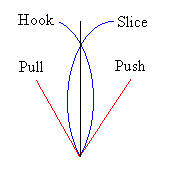 ensure
that the clubface is square with the ball on impact causing it to travel
in a straight line. Failure to position the feet along the parallel
between the ball and target are the main reasons for pushing and pulling
the ball. Failure to keep the ball centered has the same effect. If the
ball shanks or slices then the clubface is open or closed at impact thus
imparting spin. These suggest incorrect posture. ensure
that the clubface is square with the ball on impact causing it to travel
in a straight line. Failure to position the feet along the parallel
between the ball and target are the main reasons for pushing and pulling
the ball. Failure to keep the ball centered has the same effect. If the
ball shanks or slices then the clubface is open or closed at impact thus
imparting spin. These suggest incorrect posture.
However there are some variations which you can employ depending on the
circumstances. When using shorter clubs such as irons and wedges, the
feet should be moved slightly closer. When taking long shots the ball
can be moved slightly left of centre (towards the target) but no further
than the foot. The optimum positions are wholly individual and therefore
practice on the range taking short, medium and long range shots is
essential to discovering them.
|
A correct and consistent posture
lends itself to a consistent golf swing. Posture refers to the
alignment of the body as you stand over the ball and bring the club
to the address position.
To assume the correct posture, firstly adopt a box stance. This will
place your feet correctly in relation to the ball and align the body
with the target. Then place your shoulders, knees and feet in the
same vertical plane perpendicular to the ground by leaning over at
the hips and slightly bending the knees. Your back should always be
kept straight.
The body as a whole should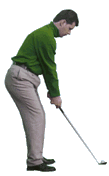 be neither crouched nor upright as the club is brought to address
the ball; shuffle forward or backwards as required. Note that your
left shoulder will naturally drop because of the position of the
hands when taking up the grip.
be neither crouched nor upright as the club is brought to address
the ball; shuffle forward or backwards as required. Note that your
left shoulder will naturally drop because of the position of the
hands when taking up the grip.
Given that posture should be maintained, you stand further from or
closer to the ball depending on the length of club being played.

If your posture is incorrect then you will tend to produce slices
and hooks. Slices can be caused by standing too close to the ball.
In this situation the posture is too upright causing the ball to be
attacked from out to in. This produces a strike across the ball and
imparts spin. Conversely hooks are caused by standing too far from
the ball. Here the posture is crouched and the ball is attacked from
in to out.
If you are sure that you have adopted the correct stance and are
producing wayward shots then it very likely that they are caused by
poor posture. As always, practice and a degree of experimentation on
the range are required to make correct posture second nature.
|
|
|
US CITIZENS: The
information contained herein is for entertainment and news matter
only. Any use of this information in violation of federal, state and
local law is strictly prohibited. Offers by offshore sportsbooks
advertising on this site are void in states where prohibited by law.
Please check with your local or state enforcement agency. |
|
|
|
